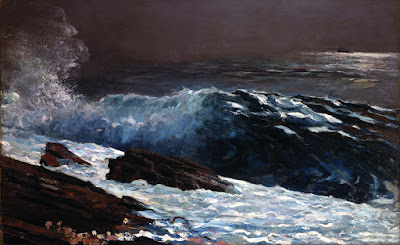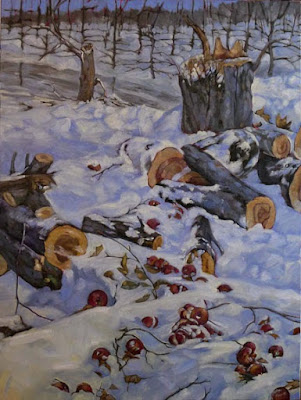The best way to learn about your brushes is to experiment, but meanwhile, here’s a handy guide to oil painting brushes.
Plein air painters usually favor hog’s bristle brushes. These are far less expensive than softer hairs like sable. They are the only brushes that spread thick paint smoothly and evenly, making for the freshest technique.
Bristle brushes tend to form a flag (a v-shaped split) at the end over time. However, if the brush is made properly, with good interlocking bristles, it will have a natural resistance to fraying. Because field painters often go long periods without being able to clean their brushes, this durability is important.
There are some good synthetic brushes on the market, but none of them are quite as stiff as a good natural bristle brush.
In the following exercises, I’ve tried to keep the amount of solvent the same (except with the fan brush).
Above is a sable flat brush by Rosemary & Company. It can put down a very smooth surface and offers a lot of control, but it doesn’t carry the quantity of paint that an equivalent bristle brush will. I do have many sable brushes, but I save them for thin work in the studio.
This is a Robert Simmons Signet flat brush. The paint it lays down is both rougher and more impasto than the sable.
Flat brushes make an immediate, energetic mark. They’re excellent for fast, powerful surface work, long sweeping strokes, and blocking in shapes.
Used on their sides, they also make great lines, far more evenly than a small round can do.
Two rounds of very different sizes. A round is a more lyrical brush than a flat, and is a classic tool for painterly surface marks. It can be used to make lines that vary from thin to thick. A pointed round is used for fine detail. Bristle rounds tend to lose their points very quickly, however.
The great advantage of a filbert is the variety of brushstrokes you can get from one brush. This is great for single strokes that taper, such as in water reflections. Its rounded edges are good for blending. Set on its side, it makes nearly as good a line as a flat does.
A bright is a less-flexible version of a flat. It’s great for short, powerful strokes or situations where you want a lot of control.
A fan brush probably has no place in a plein air kit, but I carry one anyway. I use it for blending, as on the left, although some people like using it to make whacked out marks as on the right. The problem is, it can carry very little paint, so its marks tend to be either gooey, as above, or very abrupt.
In my studio, I just use a clapped out soft-haired brush to blend.
The only ‘novelty’ brush I carry is a double filbert, or Egbert, above. It’s a lyrical brush that has a lot of expressive quality.
Many plein air painters also carry liners and riggers, which are useful in paintings that are built up smoothly. I don’t paint that way, so I seldom use them. Another brush that is good for detailed work is an angled brush. However, you can do almost any work you can envision with just the brushes I’ve shown you above.
Next week, I’ll talk about watercolor brushes.


































